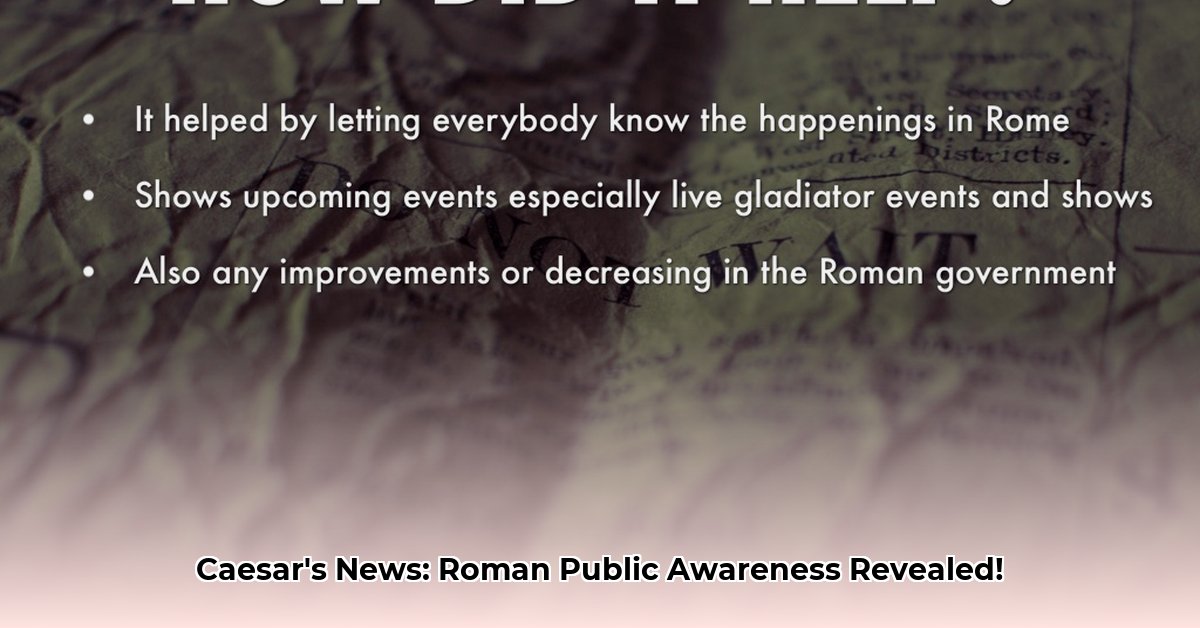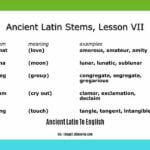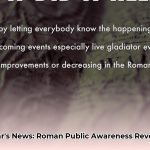Have you ever imagined a world bustling with news, long before the whisper of a printing press or flicker of a digital screen? Picture the heart of ancient Rome – a vibrant metropolis teeming with political maneuvering, gladiatorial spectacles, and the daily ebb and flow of civilian life. How did information, both critical and mundane, reach its vast populace? The answer lies in the Acta Diurna, Latin for “Daily Acts” or “Daily Public Records.” This groundbreaking public gazette, often heralded as the ancient Roman newspaper, was Rome’s pioneering system for mass communication, setting precedents for information dissemination and fostering Roman public awareness that resonate even today.
More than just a simple bulletin, the Acta Diurna served as the Roman Empire’s pulse, a daily mirror reflecting official decrees, military triumphs, and social happenings. Its enduring legacy offers profound insights into the origins of journalism, the delicate balance between state communication and public enlightenment, and the timeless human need to stay informed.
The Genesis of Daily News: A Roman Innovation
While often attributed to Julius Caesar in 59 BCE, who mandated the posting of Senate proceedings, archaeological and historical evidence suggests precursor forms of public notices, potentially carved on stone or metal, appeared as early as 131 BCE. Regardless of its precise inception, the Acta Diurna fundamentally transformed civic engagement in the Roman Empire. It moved information from hushed private discussions to public display, thereby democratizing access to official news and fostering a more informed citizenry.
Initially, these “daily acts” were laboriously inscribed on whitewashed boards, metal, or stone tablets, strategically placed in high-traffic areas such as the Roman Forum, public markets, and bathhouses. As Rome evolved, so did its news medium; by the 1st century BCE, papyrus scrolls became the preferred (though less durable) format, allowing for greater volume and easier replication. Professional scribes, employed by the Roman government, diligently compiled and copied these reports. After a few days, the notices were taken down and archived, though tragically, due to the perishable nature of papyrus and the passage of time, no intact copies survive today. Our knowledge of the Acta Diurna comes primarily from the invaluable references made by esteemed ancient historians like Suetonius, Tacitus, and Pliny the Elder, who utilized it as a primary source for their own chronicles.
A Window into Roman Life: What the Acta Diurna Reported
The content of the ancient Roman newspaper was remarkably comprehensive, offering a multifaceted glimpse into the daily life, governance, and societal fabric of the era. Far from being a dry collection of facts, the Acta Diurna covered a spectrum of news that would resonate with a diverse readership:
- Governance and Legislation: Crucial imperial decrees, senatorial proceedings (initially mandated by Caesar to weaken senatorial secrecy), assembly votes, and legislative updates directly from the heart of Caesar’s government. This ensured citizens were apprised of laws and policies directly impacting their lives.
- Legal and Judicial Matters: Detailed outcomes of civil trials, criminal proceedings, and significant legal decisions, providing transparency in the Roman justice system.
- Military Intelligence: Official dispatches from the front lines, detailing military victories, troop movements, and strategic developments. This was vital for public morale and understanding the reach of Roman power. Tacitus, in his Annals, notes how eagerly these military reports were scanned across the provinces.
- Public Works and Infrastructure: Announcements regarding the construction of new roads, aqueducts, temples, and other public projects, demonstrating the empire’s progress and investment in its infrastructure.
- Social and Cultural Events: This lighter fare brought human interest to the forefront, including significant births, deaths, and marriages of prominent citizens, announcements for grand gladiatorial combats, chariot races, and other public games that captivated the Roman populace. The Acta Diurna even featured what could be considered ancient gossip columns, detailing the amorous adventures of the rich and famous, alongside more whimsical accounts like a faithful dog finding its way home after being lost—a story recounted by Pliny the Elder.
- Economic and General Information: Reports on grain prices, treasury funds from the provinces, and even astrological readings, providing practical information and entertainment to the public.
These detailed records, often replicated by scribes and dispatched via courier to provincial governors and wealthy Romans living outside the capital, ensured a consistent and widespread flow of public information throughout the sprawling Roman Empire. This systematic approach highlights an early understanding of the power of consistent information and its role in maintaining stability, fostering loyalty, and projecting authority across a vast dominion.
From Transparency to Propaganda: The Evolving Role of Ancient News
The fascinating narrative of the Acta Diurna is not simply a story of journalistic progress; it also serves as a poignant historical case study of the complex, often fraught, relationship between information and power. While Julius Caesar’s initial intent was to enhance governmental transparency and keep the populace genuinely informed, the role of the Acta Diurna gradually evolved. As the Roman Empire consolidated power and moved away from republican ideals, the “daily acts” increasingly transformed into a potent instrument of state control and a sophisticated platform for imperial propaganda. This significant shift underscores a crucial, timeless lesson for journalistic integrity: the inherent power of information and its susceptibility to manipulation, a challenge that echoes powerfully in our contemporary media landscape.
This historical trajectory offers profound implications and actionable insights for modern understanding and practice:
- For Historians: The Acta Diurna, though fragmented, remains an indispensable historical record. By cross-referencing its mentions in classical texts with surviving epigraphic evidence and archaeological findings, scholars can reconstruct more accurately the daily lives, political machinations, and social concerns of ordinary Romans. Future advances in computational linguistics and AI could even hypothesize likely content, offering unprecedented fresh perspectives on Roman daily life.
- For Journalists: The Acta Diurna‘s evolution vividly illustrates the historical tension between governmental information and independent reporting. Its transition from a tool of transparency to a vehicle for imperial messaging provides a clear precedent for understanding contemporary challenges related to media bias, government influence, and the imperative of maintaining editorial independence. It serves as a stark reminder of the ethical responsibilities inherent in information dissemination.
- For Educators: Incorporating the Acta Diurna into curricula offers an unparalleled opportunity to introduce students to the foundational origins of journalism and the vital role of information in ancient societies. Drawing direct comparisons with modern news sources—from digital publications to social media feeds—can foster essential critical thinking skills, prompting students to analyze sources, identify potential biases, and understand the profound impact of news on public perception and civic engagement. This directly contributes to media literacy development.
Ultimately, the Acta Diurna was far from perfect. Its limitations, including a lack of independent verification and its eventual susceptibility to political manipulation, were evident even in its own time. Yet, it represents a pivotal, innovative step in the long, arduous development of public communication. It reminds us that the enduring pursuit of a free, transparent, and informed society is a journey that began millennia ago, long before the advent of the printing press, broadcasting, or the internet.
Rome’s Enduring Legacy: Lessons for Modern Media and Public Awareness
The captivating story of the Acta Diurna offers a rich tapestry of insights into the foundational principles of news and its indispensable societal role. It provides a timeless historical blueprint for understanding current dynamics in global media, governance, and public awareness, underscoring the perpetual human need for timely, accurate, and transparent historical records.
Here are key, actionable takeaways that resonate from Rome’s pioneering “daily acts” to our complex, information-saturated modern landscape:
- Prioritize Transparency, Vigilantly Guard Against Control: Just as Julius Caesar’s initial vision for the Acta Diurna aimed for greater governmental transparency, modern governments and media organizations must continually prioritize open, accessible information. However, the Acta Diurna‘s later transformation into a tool for imperial control serves as a powerful and timeless warning. Journalists, media watchdogs, and engaged citizens must remain perpetually vigilant against potential state control, corporate influence, or hidden agendas, ensuring that information serves the public good, not merely the interests of power.
- Cultivate Robust Critical Media Literacy: The historical susceptibility of even ancient news to manipulation underscores the absolute necessity of fostering strong critical thinking skills in citizens of all ages. This involves actively analyzing sources, identifying potential biases, scrutinizing the motivations behind information dissemination, and understanding the nuances of how news is framed. This is a crucial component of Future Proofing – Acta Diurna – Teach Media Bias, equipping individuals to navigate an increasingly complex information ecosystem.
- Innovate for Accessibility, Unwaveringly Preserve Integrity: The very genesis and widespread popularity of the Acta Diurna speaks to an ancient, innate human drive for information accessibility. Today, as media constantly evolves (from traditional print to dynamic digital platforms, social media, and emerging AI-driven news models), the core imperative remains unchanged: to deliver news widely and inclusively while simultaneously upholding the highest possible standards of journalistic integrity, accuracy, and ethical responsibility. This ensures that the fundamental goal of informing the public—a goal central to the Acta Diurna over two millennia ago—continues to be met responsibly and effectively in the digital age.
The legacy of the Acta Diurna unequivocally underscores that the intrinsic challenges and profound responsibilities of information dissemination are eternal. It serves as a compelling, enduring reminder that the noble pursuit of a well-informed citizenry is an ongoing, evolving endeavor, one deeply rooted in the daily acts and public notices of ancient Rome.
















